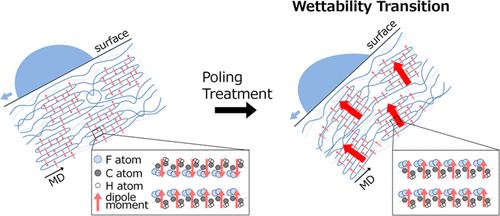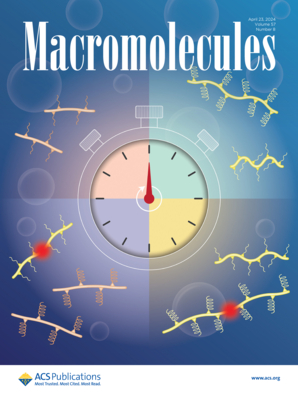Poling-Induced Wettability Transition of a Uniaxially Oriented Poly(vinylidene fluoride) Film
IF 5.1
1区 化学
Q1 POLYMER SCIENCE
引用次数: 0
Abstract
The surface wettability of polymers can be controlled by van der Waals interactions, which include induction, orientation, and dispersion forces. For most fluoropolymers, the effect of orientation interactions is markedly smaller than the others, particularly in structures with antiparallel packing, where permanent dipoles may cancel each other out. However, poly(vinylidene fluoride) (PVDF), a semicrystalline polymer, exhibits unique piezoelectric properties when its polar β-form crystals are oriented via poling treatment. This study investigates how such orientation influences surface wettability. We demonstrate that the wettability of uniaxially oriented PVDF films changes with poling treatment. Using sum frequency generation spectroscopy and grazing incidence X-ray diffraction measurements, we found that the b-axis of the β-form crystals near the surface aligns perpendicular to the surface under sufficient electric field strength. This alignment facilitates a transition in wettability, which is discussed in terms of dipole interactions near the surface. Our findings contribute to a deeper understanding of the interplay between molecular orientation and surface properties in semicrystalline polymers.

单轴取向聚偏氟乙烯薄膜的极化诱导浸润性转变
聚合物的表面润湿性可由范德华相互作用控制,其中包括感应力、取向力和分散力。对于大多数含氟聚合物来说,取向相互作用力的影响明显小于其他相互作用力,特别是在反平行堆积结构中,永久偶极子可能会相互抵消。然而,聚偏二氟乙烯(PVDF)是一种半结晶聚合物,当其极性 β 型晶体通过极化处理取向时,会表现出独特的压电特性。本研究探讨了这种取向如何影响表面润湿性。我们证明了单轴取向 PVDF 薄膜的润湿性会随着极化处理而发生变化。通过使用和频发生光谱和掠入射 X 射线衍射测量,我们发现在足够的电场强度下,表面附近的 β 型晶体的 b 轴会垂直于表面排列。这种排列促进了润湿性的转变,我们将从表面附近的偶极子相互作用角度对此进行讨论。我们的发现有助于加深对半结晶聚合物中分子取向与表面特性之间相互作用的理解。
本文章由计算机程序翻译,如有差异,请以英文原文为准。
求助全文
约1分钟内获得全文
求助全文
来源期刊

Macromolecules
工程技术-高分子科学
CiteScore
9.30
自引率
16.40%
发文量
942
审稿时长
2 months
期刊介绍:
Macromolecules publishes original, fundamental, and impactful research on all aspects of polymer science. Topics of interest include synthesis (e.g., controlled polymerizations, polymerization catalysis, post polymerization modification, new monomer structures and polymer architectures, and polymerization mechanisms/kinetics analysis); phase behavior, thermodynamics, dynamic, and ordering/disordering phenomena (e.g., self-assembly, gelation, crystallization, solution/melt/solid-state characteristics); structure and properties (e.g., mechanical and rheological properties, surface/interfacial characteristics, electronic and transport properties); new state of the art characterization (e.g., spectroscopy, scattering, microscopy, rheology), simulation (e.g., Monte Carlo, molecular dynamics, multi-scale/coarse-grained modeling), and theoretical methods. Renewable/sustainable polymers, polymer networks, responsive polymers, electro-, magneto- and opto-active macromolecules, inorganic polymers, charge-transporting polymers (ion-containing, semiconducting, and conducting), nanostructured polymers, and polymer composites are also of interest. Typical papers published in Macromolecules showcase important and innovative concepts, experimental methods/observations, and theoretical/computational approaches that demonstrate a fundamental advance in the understanding of polymers.
 求助内容:
求助内容: 应助结果提醒方式:
应助结果提醒方式:


